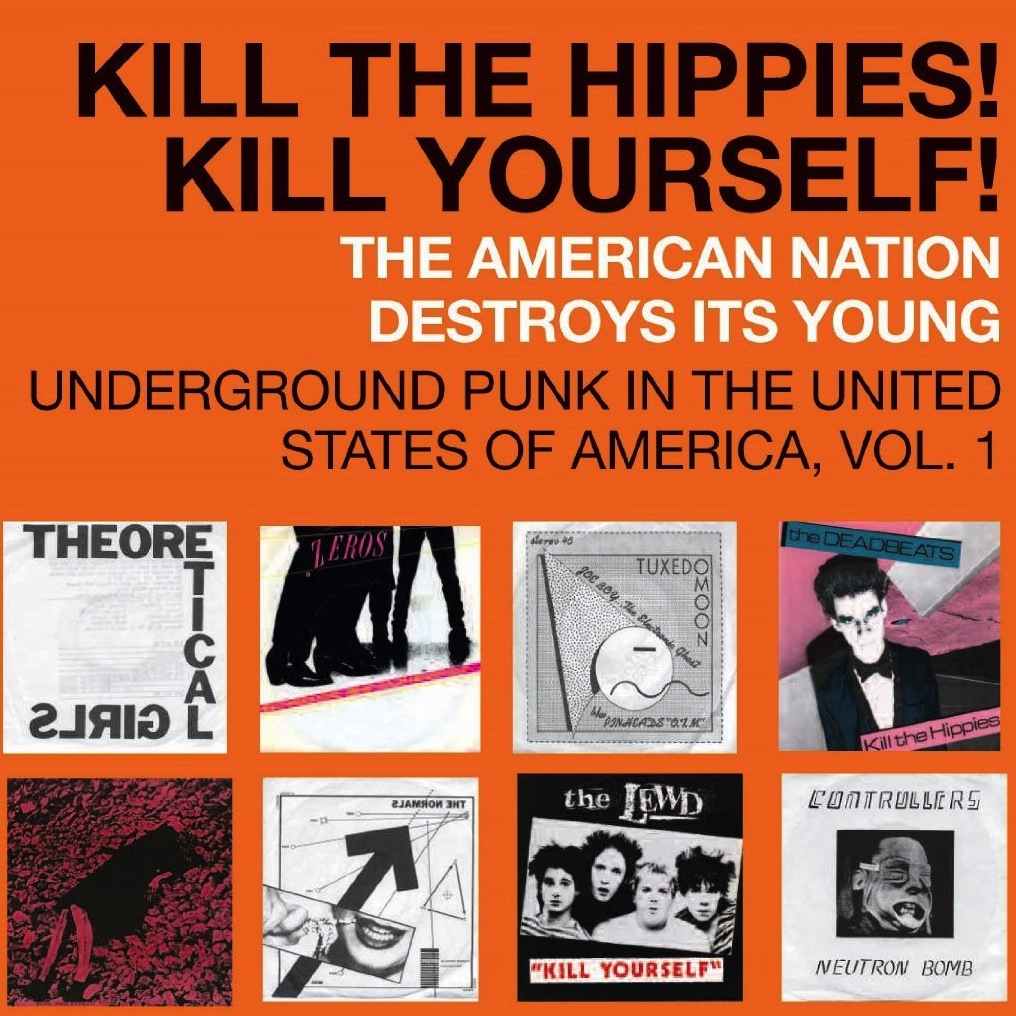Released to coincide with a weighty new tome on punk cover art co-edited by Jon Savage, Punk 45: Kill The Hippies! Kill Yourself! is a compilation of (mostly) obscure US garage rock, proto-hardcore, art pop and no wave singles put together by the ever reliable Soul Jazz label. Covering the period 1973 to1980, it’s a compelling overview of the underground sounds being made outside of the American major label music machine, driven by “a general despising of the omnipotent corporate rock that ruled the airwaves… matched to an equally numbing emptiness and alienation experienced by those brought up in the dysfunctional middle class suburban existence of their parents’ generation”, as the excellent sleeve notes have it.
What it’s quick to point out is the way in which the initial New York punk scene was quickly co-opted and made-over as the more consumer-friendly ‘new wave’ by those major labels, leaving local scenes outside of the metropolis isolated and under-exposed once the bandwagon had swiftly moved on. In fact, there’s an almost indecent haste with which the likes of the Ramones, Television, Patti Smith, Blondie etc allow themselves to be signed up, all the better to more quickly stake a claim on the trad rock canon/get into the charts/develop serious drug habits (delete as applicable).
Whereas the then influential music papers and incidents such as the Bill Grundy swearathon were able to kick-start and sustain a national punk scene in the UK (albeit one still based for the most part around the capital), the more conservative US media held its nose and waited for the next youth fad to come along. The States is a vast country, and without the unifying call to action that rang out across our small island, local bands were forced to create their own micro-scenes without any particular hope of (or indeed aspiration to) reaching a mass audience. Or as the sleeve notes eloquently put it, “this is the story of the fuckyous who stayed in their hometown to make a noise.”
So what’s the music like? As with all Soul Jazz compilations, it’s a smart, appealingly programmed album with a high hit rate and a smattering of real gems. A lot of the tracks are very much of their time, enjoyably cartoonish or anti-authoritarian without necessarily being socially conscious. But the best of the songs try to bypass the provincial vibe and create a new type of sound that genuinely challenges the sonic hegemony of 70s AOR.
This is borne out by the album’s opening selection of songs: The Urinals’ wilfully primitive ‘I’m A Bug’; The Normals’ Ramones homage ‘Almost Ready’; The Hollywood Squares’ great Dead Kennedys’ soundalike ‘Hillside Strangler’; Electric Eels’ poisonous glam stomper ‘Agitated’. And then we get to Pere Ubu’s ‘The Modern Dance’, and we’re in different territory altogether – they called it avant garage, but it’d actually sound like some kind of groovy Kraut-inflected prog if it weren’t for David Thomas’s extraordinary hectoring vocals.
Other highlights include The Bizarros’ ‘Ice Age’, a cleverly arranged slice of operatic punk with the singer’s mannered delivery reminiscent of Tom Verlaine or Howard DeVoto; the balls-out, maximum rock & roll of The Skunks’ ‘Earthquake Shake’; Pastiche’s ‘Flash of the Moment’, which tempts fate by evoking both Mott the Hoople and The Only Ones; and the sinister riffage and angry anomie of The Controllers’ ‘Neutron Bomb’.
And then there’s the weirder stuff, which shows that beyond just sticking it to the Man, there was a pioneering sensibility at work that might not always have produced amazing songs, but clearly informed a lot of alternative music to come. Tracks in this category include Tuxedomoon’s ‘Joeboy The Electronic Ghost’, which sounds almost exactly like Here Come The Warm Jets-era Eno fronted by Poly Styrene; Theoretical Girls’ ‘U.S. Millie’, a peculiar staccato march that seems to reference Steve Reich (but doesn’t clue you in to the presence of Glenn Branca in their ranks); and oddest of all, Crash Course in Science’s robotic ‘Cakes in the Home’, which stutters and trills like a broken Stepford Wife. Interestingly, these tracks are the only ones on the album to feature female performers.
However, for the most part, your enjoyment of this compilation will depend on your enthusiasm/tolerance for shouty blokes with scratchy guitars, knocking out a basic riff and seeing where it takes them. While punk might not have ‘broke’ in America until 1991 (at least according to Sonic Youth), this album is ample evidence that its spirit was alive and kicking long before then if only you knew where to look.


